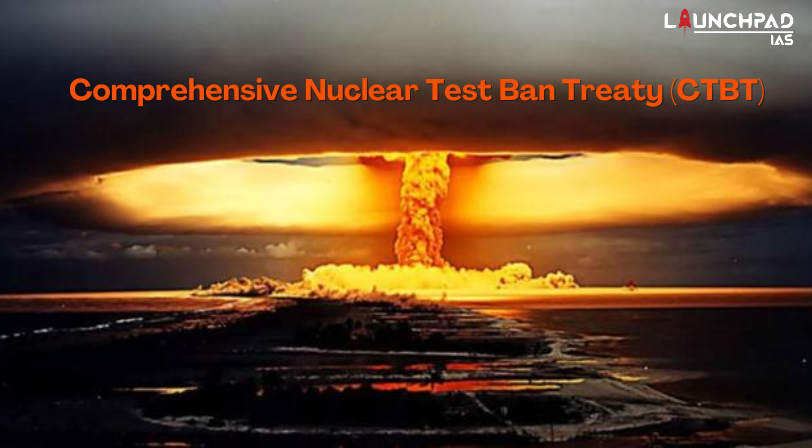What is the Comprehensive Nuclear Test Ban Treaty (CTBT)?
- The Comprehensive Nuclear Test Ban Treaty (CTBT) is a multilateral treaty aimed at banning all nuclear explosions, whether for military or peaceful purposes.
- The roots of the CTBT can be traced back to the Cold War era when the United States and the Soviet Union were engaged in a nuclear arms race, conducting numerous nuclear tests.
- Between 1945 and 1996, over 2,000 nuclear tests took place globally, with the U.S. conducting 1,032 tests and the Soviet Union conducting 715 tests, among others.
- In response to concerns about the environmental and health impacts of nuclear tests, the international community made efforts to limit testing.
- The Limited Nuclear Test-Ban Treaty (LTBT) of 1963 prohibited nuclear testing in the atmosphere, outer space, and underwater but allowed underground tests.
- The Threshold Test Ban Treaty (TTBT) of 1974 prohibits underground nuclear weapons tests and establishes a nuclear “threshold,” yet it falls short of providing a comprehensive ban on all nuclear testing.
- CTBT: The end of the Cold War and the dissolution of the Soviet Union created a conducive environment for comprehensive arms control measures.
- The CTBT was negotiated at the Conference on Disarmament in Geneva in 1994.
- In 1996, the United Nations adopted the CTBT, which imposed a complete ban on nuclear weapons testing, closing the gaps left by previous treaties.
- The CTBT became available for signature in September 1996, signifying a major advancement in the global endeavor to halt nuclear testing across the world.
- The CTBT will enter into force 180 days after it has been ratified by all 44 states listed in Annex 2 of the treaty, which are states that possessed nuclear reactors or research reactors at the time of its adoption.
How did CTBT come into existence?
- The 1940s – The USA conducted the world’s 1st successful nuclear weapons test in 1945 whereas the Soviet Union tested its 1st nuclear weapon in 1949.
- These tests triggered a decades-long arms race between the two superpowers.
- Between 1945 and 1996, more than 2,000 nuclear tests were carried out.
- 1960s- Limited Nuclear Test-Ban Treaty (LTBT), 1963 prohibited nuclear testing in the atmosphere, outer space, and underwater, but underground tests were still permitted.
- 1970s – The US and Soviet Union agreed to sign the Threshold Test Ban Treaty (TTBT), which established a nuclear threshold by banning the two countries from conducting tests that would produce a yield exceeding 150 kilotons (equivalent to 150,000 tons of TNT).
- The 1990s- A breakthrough came after the Cold War ended through the CTBT in 1996 that will prohibit all nuclear weapons tests and other nuclear explosions upon its entry into force
What is India’s Stand on CTBT?
India is a member of the Multilateral Export Control Regime (Australia Group, Wassenar Agreement, Missile Technology Control Regime) except the Nuclear Suppliers Group.
- Standstill agreement– It was launched by India in 1954, by then Prime Minister Jawaharlal Nehru.
- Testing of all nuclear weapons was to be immediately suspended, pending an agreement on their complete prohibition.
- LTBT– Nehru played an important role in building international momentum for the 1963 Limited Test Ban Treaty, which India joined.
- CTBT – India did not support the treaty in 1996 and still does not, but it had been very supportive during negotiations.
- Security concerns – India considers the enforcement of the treaty as a threat to national security.
- Discriminatory – The US has already conducted more than 2000 tests and suddenly realizes that there was no need to test nuclear devices anymore.
- Time limit – No time-bound disarmament schedule for nuclear weapon states
- Limited Coverage– CTBT would not help with nuclear disarmament since it only banned nuclear explosive testing, but not other activities related to nuclear weapons, such as sub-critical (non-nuclear explosive) experiments, or computer simulations.
- In 2016, the CTBTO invited India to become an “Observer” in the CTBT. However, India has not signed the treaty.
Major Problems with the Treaty
- The major problem with this treaty is that still, several countries have refused to comply with the norms of this treaty. Large countries like China and India are also among these countries. This prevents the treaty from becoming a universal mandate.
- However given the immense importance of having control over nuclear power, President Barack Obama had requested the UNSC to get the treaty passed by all the member States. But that proposal also failed to get an international consensus. Therefore if we see the present situation of this treaty, its impact is contingent on ratification from 44 states.


